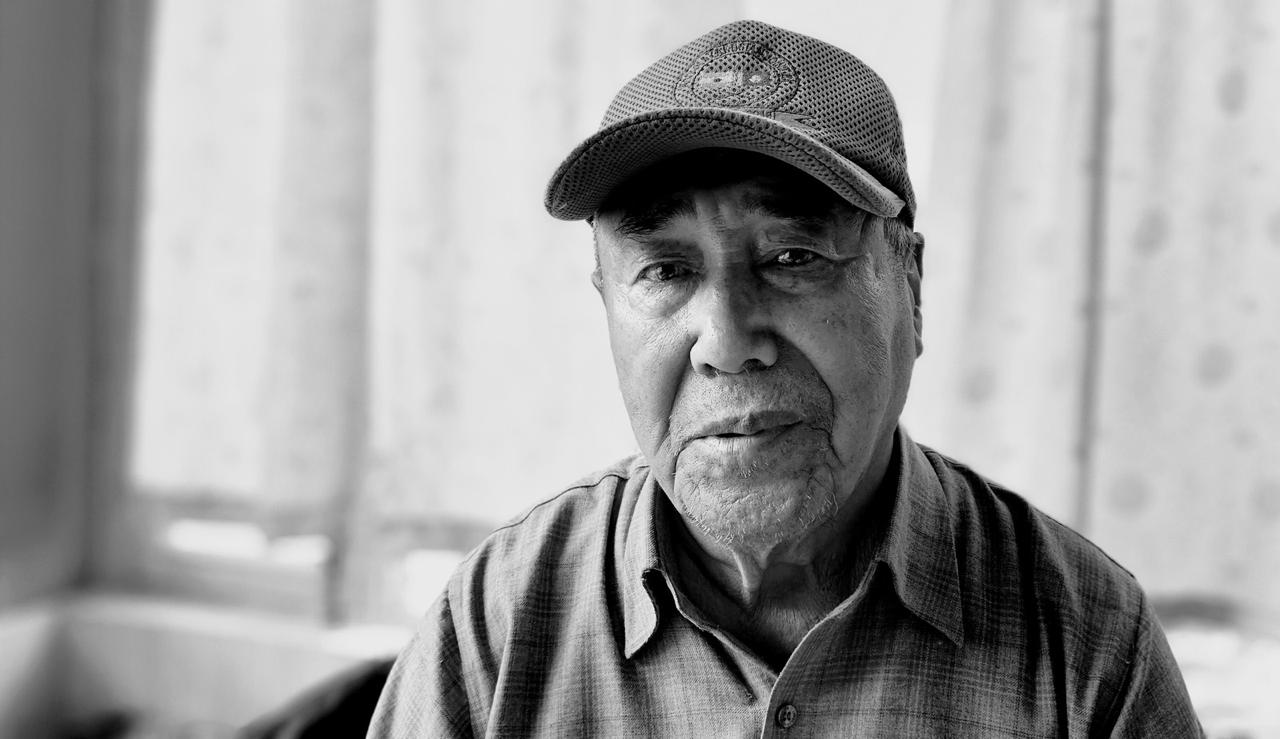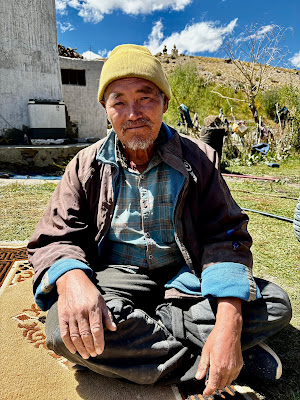Stanzin Tsewang, now 96-year-old, from Kyagar village in Nubra, Ladakh, is widely respected as an authority on the routes and geography of Nubra. Drawing from the Ladags Gyalrabs, Stanzin traces the history of Ladakh’s connections with the Hors—people of Turkic origin from north of the Karakoram mountains—stretching back a thousand years. According to this account, around the 10th century AD, a chieftain named Gyapa Cho in upper Indus faced repeated raids by the Hors, who crossed the Karakoram Pass to plunder the region. Hearing of Skyid lde nyi ma mgon the founder of the Ngari Khorsum Empire, Gyapa Cho invited him to counter these incursions, offering land in Shey as a reward.
It is also mentioned in the Ladags Gyalrabs that in the 16th century, King Tsewang Namgyal of Ladakh considered launching a counter-invasion into the Hors’ territory across the Karakoram, but the people of Nubra, reliant on trade with the Hors, persuaded him to abandon the plan to safeguard their economic interests.
Stanzin recalls that during his youth, the Hors arrived in Nubra each summer, traveling in camel caravans over the Saser La Pass and descending through Tulum Putit La into the Nubra Valley at Sasoma. In Panamik, they would camp at Bhap Kothi, a storage area used by the Dogra government to collect taxes from villagers from Panamik and nearby settlements. This site served as a vital camping point for the Hors before they continued on to Leh. Stanzin also mentions an old practice called Nangskor, where the Hors camped on lands owned by specific Nubra families, using the grass for animal feed. Typically, a Hor trader traveled with about 10 servants, known as Chakars, who cared for the animals and goods, set up tents, and prepared food. According to Stanzin, the trader, the leader of the group was addressed as Bhai. The Hors brought items such as Kaleen (carpets), silk, and Baang and Charas (forms of cannabis); the scent of charas was strong, easily noticed as their camel caravans, loaded with goods, passed through Nubra. The Hors traded for cash, grazing rights, and collected medicinal plants: Mandok from Ladakh.
The Hor caravans typically consisted of two groups: traders, who moved on to Leh, and pilgrims (Hajis) who journeyed through Zojila to Kashmir and continued to Mecca, possibly by sea. They traveled through Nubra Valley, stopping at Panamik, Terisha, Kyagar, Terit, and other villages before crossing Khardung La to reach Leh. In winter, they took the Chang La Pass. Conscious of the harsh winter, the Hors aimed to return in Ston (autumn) before the passes closed. Stanzin recalls that some traders from Hoshiarpur in Leh often joined the Hors caravans to Yarkand in autumn to trade and returned the following summer. Many Hajis, however, did not return to Ladakh, possibly taking alternate routes after completing their pilgrimage.
Travelers from both Ladakh and Yarkand made the journey, returning once the passes reopened, but some chose to settle in new lands. Stanzin remembers a man named Gulam from the Lakjungpa family who moved to Yarkand with his family. Similarly, some Hors decided to settle in Ladakh, like Ahsan Bhai from Hargam village, a descendant of Yarkandi parents who established himself permanently in Nubra.
According to Stanzin, in the first half of the 20th century when the Leh-Yarkand trade was on, the Hors were so integrated into Nubra’s life that, Ladakhis along the Panamik route would use Hor words into their daily language. Common terms included “Su” for water, “keling keling” for “come,” “At” for horse, and “Ishak” for donkey.
Stanzin lists out examples to cite the legacy of the now abadoned Leh-Yarkand trade preserved in Turkic-origin place names along the route. For example, Daulet Beg Oldie, meaning “place where the rich man died,” in Turki language, refers to Said Khan of Yarkand, who perished there in the 14th century. His nephew, Mirza Haider, who invaded Ladakh with him, records his conquests—including the massacre of Nubra residents who resisted him—in the Tariq-e-Rashidi. Another location, Sultan Chusku, according to Stanzin is named after a wealthy Hor trader named Sultan, who frequently used it as a resting and grazing ground. Other place names, such as Chong Kumdan (large dam), Kichik Kumdan (small dam), Chongthar (“big boulder”), and Ak Tash (“white stone”) near Saser Brangsa, retain the influence of the Hor language and mark their historical presence in Nubra.
According to Stanzin these exchanges and interactions continued until the early 1950s, when political tensions and border issues at the Karakoram Pass ended the Hors’ visits. By 1955, with closed borders and shifting geopolitics, the Hors’ travels to Ladakh came to a permanent end.
Wangdus Nurbu Kalon, now 83, from Tegar village in Nubra, Ladakh, was born into the prominent Srah-ngara family of Leh. This distinguished family played a significant role in the famous Lopchak trade missions from Ladakh to Tibet, an integral part of Ladakh’s historic trade network. His great grandfather, Dawa Shah, and uncle, Tonyot Shah, who frequently led these missions, were important central figures in the 20th-century trade history of Ladakh. Although Wangdus moved to Nubra in 1962, his early years in Leh gave him rare firsthand experience of the Hors’ visits to Leh—an experience few Ladakhis share today.
The Hors journeyed to Leh by crossing Saser La, Tulum putit La to Sasoma then crossing the Nubra valley finally descending down the Khardungla to enter Leh. Wangdus recalls the annual arrival of the Hors, each summer. The men traders were referred to as Khwaja, and the women as Khanum. His ancestral land in Leh was a favored stop for the Hors, along with other traditional resting places like the current police station Leh and the Sarai at Zangsti now a parking lot and public restroom. At Zangsti, a two-story building offered the Hors accommodations on the upper level, while their camels, horses, and notably large donkeys were kept below.
The Hors brought with them long-grain basmati rice, raisins, and sheep with large, fatty tails—a delicacy shared with locals who bought meat at the traders’ camps. Wangdus remembers them brewing Kawa chai, known as Singyaa, in a Samawar, a Central Asian kettle. After trading in Leh, the Hors would often continue to Kashmir, leaving their camels behind, and return months later carrying spices.
Wangdus recalls a phrase from the Hors, “Yaxshi ba, qaytsi bama, qandaq ka le ma.” a loose translation would mean something close to - "good, are you going back" ? They also used the term “Obdang” frequently as a word of praise. The Hors brought valuable items like kaleen (carpets) and other Yarkandi goods, and Wangdus’ family, one of the wealthier families in Nubra, still has a collection of Yarkandi items, including carpets and utensils.
One particular memory stands out: A Deputy Commissioner of Ladakh, a frequent visitor to Nubra, and a friend of the Kalon family, enjoyed a song celebrating the memory of visiting Hors, sung by one Tsewang from Terisha. Though the Hors no longer visit Ladakh, the song endures, and Wangdus remembers the Deputy Commissioner's delight as Tsewang performed, balancing on one leg, jumping and singing, “Achir Khan lo, Wachir Khan lo, wai wai jaan, Yarkand Khwaja Obdan, wai wai bhai jaan,” as the Deputy Commissioner laughed and clapped along. This song, rich with memories of the Hors, remains a treasured piece of Nubra’s history.
Havaldar Punchok Stobdan, Vir Chakra, now 86 and from the Khampa Gongma family in Panamik village, Nubra, is a distinguished veteran of two wars. He was awarded, The Chief of Army Staff Commendation Card, in 1962 and later received the Vir Chakra for his bravery in the 1971 war with Pakistan.
In his youth, Stobdan recalls the annual arrival of the Hors—Yarkandi traders—each summer, typically in the 4th or 5th month when the Saser La pass reopened. Traveling in small groups of 5-6, the traders would suddenly descend into Nubra with over a hundred camels, a breathtaking sight in the valley. According to Stobdan, traders on the Leh-Yarkand route meticulously planned their loads, balancing up to 50 kg in sturdy Pyingpa bags on each horse and adjusting the width to fit the Leh-Yarkand trade route’s narrowest sections, only 6.5 feet across.
In Panamik, a government-run Godown served as a tax collection center, where villagers contributed a portion of their harvest. Upon arrival, the Hors would first visit the Kutidar, the official in charge of the Godown, presenting certificates from Yarkandi authorities that entitled them to a free barley supply as part of an agreement established under British jurisdiction over the Leh-Yarkand trade route. Some Hors cleaned the barley to take to Leh, while others used it as animal feed, and some took it to local grinders to make Phey (flour).
The Hors typically camped for 3-4 days near the Kutti Godown in Panamik and on private lands owned by various families, including Stobdan’s ancestral home. This arrangement, known as Nangskor, allowed the Hors to stay with specific families in Nubra each year and use their Olthang (grass fields) as fodder for their animals in exchange of gifts from Yarkand.
Stobdan’s grandfather, Sonam Tsepal, was highly respected among the Hors and frequently traveled to Yarkand. Known for his exceptional horses, Sonam often rented them to the Hors to transport goods back to Yarkand, often accompanying them himself. According to Stobdan, the Hors’ servants, known as Chakars, set up tents across Panamik. They would cook fragrant basmati rice from Yarkand, its aroma spreading through the valley and making it a beloved delicacy among the people of Nubra. The traders also brought sheep with distinctive round, fatty tails, which they prepared and cooked at their campsites.
The Hors traded items such as carpets, Namda, and Pyingpa of different types - Kha Marpo—some adorned with mentok (floral) designs and others left plain. They also brought silk and precious metals like gold and silver, locally known as Gyastat. Charas was another popular item, and Stobdan recalls a Charas Munshi, an official at Panamik who oversaw the entry of Charas from Central Asia into Ladakh. The people of Nubra frequently bought animals from the Hors, with horses priced at Rs. 1 and donkeys at 8 annas. A person named Labor Rigzin was known for owning a camel, while the Kalon family owned the largest collection of animals in the area. The Hors often stored goods with locals in Nubra, and collecting them the following year.
Like Wangdus Nurbu and Stanzin Tsewang, Stobdan remembers phrases in the Hor language, such as "Bugun Tureyan Bar miz" loosely meaning “Would you stay back?”
*The author extends sincere gratitude to the Honorable Councillor of Panamik, Tsering Sangdup le, for his invaluable support in facilitating this visit.







.jpeg)







